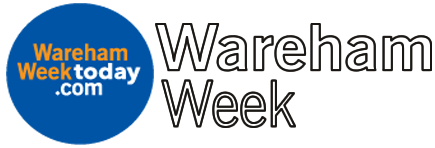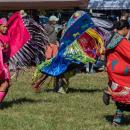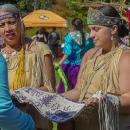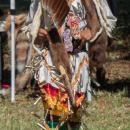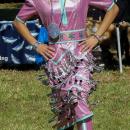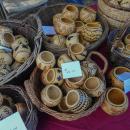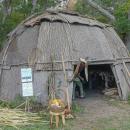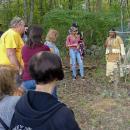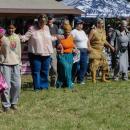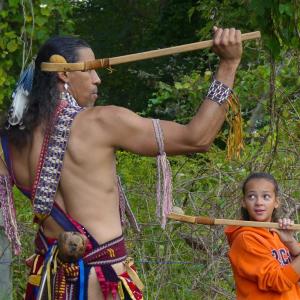Wampanoag powwow celebrates Native culture in the South Coast
 Annawon Weeden shows Xylah Cauley, 12, how to play a traditional game. Photos by Abby Van Selous
Annawon Weeden shows Xylah Cauley, 12, how to play a traditional game. Photos by Abby Van Selous Attendees join hands in a social dance.
Attendees join hands in a social dance. A dancer moves her shawl to imitate how butterflies fly.
A dancer moves her shawl to imitate how butterflies fly. Wesley Greendeer, 12, dances in the grass dance, which is often performed in preparation for a ceremony.
Wesley Greendeer, 12, dances in the grass dance, which is often performed in preparation for a ceremony. Toodie Coombs cooks two bluefish in a cooking demonstration.
Toodie Coombs cooks two bluefish in a cooking demonstration. Annawon Weeden dances to the veteran’s song in honor of veterans.
Annawon Weeden dances to the veteran’s song in honor of veterans.  Dancers move like butterflies.
Dancers move like butterflies. Attendees are shown a handcrafted belt.
Attendees are shown a handcrafted belt. Ivy Machado, 10, dances.
Ivy Machado, 10, dances. Ciara Dickerson, 13, dances during the powwow.
Ciara Dickerson, 13, dances during the powwow. A vendor at the powwow sells hand-painted cups made out of gourds that she grew.
A vendor at the powwow sells hand-painted cups made out of gourds that she grew. Guests explore the wetu that was built during the Wampanoag Experience Powwow in 2022.
Guests explore the wetu that was built during the Wampanoag Experience Powwow in 2022. Dolls are often made out of corn husks.
Dolls are often made out of corn husks. One of the fancy shawl dancers prepares to dance in a demonstration that imitates how butterflies fly through flowers.
One of the fancy shawl dancers prepares to dance in a demonstration that imitates how butterflies fly through flowers. Attendees create two circles and dance around each other.
Attendees create two circles and dance around each other. Toodie Coombs explains to attendees how she cooks fish and other food.
Toodie Coombs explains to attendees how she cooks fish and other food. Attendees join hands to dance together.
Attendees join hands to dance together. Annawon Weeden shows Xylah Cauley, 12, how to play a traditional game. Photos by Abby Van Selous
Annawon Weeden shows Xylah Cauley, 12, how to play a traditional game. Photos by Abby Van Selous Attendees join hands in a social dance.
Attendees join hands in a social dance. A dancer moves her shawl to imitate how butterflies fly.
A dancer moves her shawl to imitate how butterflies fly. Wesley Greendeer, 12, dances in the grass dance, which is often performed in preparation for a ceremony.
Wesley Greendeer, 12, dances in the grass dance, which is often performed in preparation for a ceremony.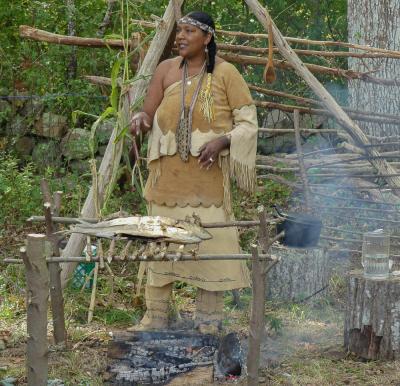 Toodie Coombs cooks two bluefish in a cooking demonstration.
Toodie Coombs cooks two bluefish in a cooking demonstration.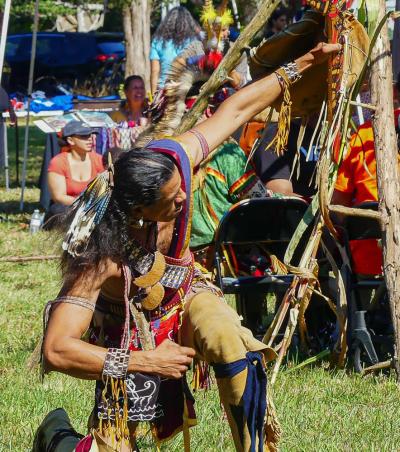 Annawon Weeden dances to the veteran’s song in honor of veterans.
Annawon Weeden dances to the veteran’s song in honor of veterans.  Dancers move like butterflies.
Dancers move like butterflies. Attendees are shown a handcrafted belt.
Attendees are shown a handcrafted belt. Ivy Machado, 10, dances.
Ivy Machado, 10, dances. Ciara Dickerson, 13, dances during the powwow.
Ciara Dickerson, 13, dances during the powwow. A vendor at the powwow sells hand-painted cups made out of gourds that she grew.
A vendor at the powwow sells hand-painted cups made out of gourds that she grew. Guests explore the wetu that was built during the Wampanoag Experience Powwow in 2022.
Guests explore the wetu that was built during the Wampanoag Experience Powwow in 2022. Dolls are often made out of corn husks.
Dolls are often made out of corn husks. One of the fancy shawl dancers prepares to dance in a demonstration that imitates how butterflies fly through flowers.
One of the fancy shawl dancers prepares to dance in a demonstration that imitates how butterflies fly through flowers. Attendees create two circles and dance around each other.
Attendees create two circles and dance around each other. Toodie Coombs explains to attendees how she cooks fish and other food.
Toodie Coombs explains to attendees how she cooks fish and other food. Attendees join hands to dance together.
Attendees join hands to dance together.Smoke billowed across Wetu Field, rising from a tended fire slow-cooking two bluefish. It wafted through the air, bringing the scents of different types of wood to drummers, people dancing in their Native regalia, kids playing traditional games and vendors selling handcrafted artwork.
On Saturday, Oct. 5, hundreds of people gathered together to celebrate and share the cultures and stories of Native and Indigenous peoples during the Wampanoag Experience Powwow.
“We’re here within our territory to let people know the culture of the original people from here,” said Earl Mills Jr, who is part of the Mashpee Wampanoag Tribe and the powwow’s emcee.
The powwow on Saturday, which was hosted at Round the Bend Farm, gave people the chance to fully embrace their heritage, culture and traditions.
“Many of our people live out in the dominant society and don’t often have an opportunity to put on their feathers and feel comfortable being Native in their homelands,” Mills said.
Attending a powwow gives people a chance to embrace and take part in their Native culture, he said.
The Wampanoag Experience Powwow included several dances, a cooking demonstration, activities for kids, such as creating shell necklaces, archery and a tour of a wetu.
“These are valuable opportunities for families to come out and practice their culture and to be around craftspeople and maybe learn a new skill, whether it’s making fiber from milkweed,” Mills said.
An integral part of the event were the various songs dances throughout the day, including a veteran’s song, social dances and a grass dance.
“You would stomp the grass if there’s a ceremony or something happening later in the day,” said 12-year-old Wesley Greendeer. “They would bring the grass dancers to stomp the grass down.”
In the 21st century it is particularly difficult to keep these culturally important skills and traditions alive, Mills said.
“These powwows are opportunities to reconnect people with this knowledge and to continue it through the generations,” Mills said.
Lisa Cauley grew up going to powwows, and now that she has kids of her own, she makes sure she brings them to powwows as often as she can.
“We go to a lot of powwows,” she said. “We’ve had a little rough summer, so we haven’t been able to go, so when we saw this one listed, we had to be here.”
Cauley started going to powwows with her family when her oldest daughter, who is now 12, was about 3 or 4 years old because she wanted her children to get some “cultural history,” she said.
“It’s nice to have things like this that you can physically be at, as opposed to just reading things in a book,” she added. “That’s big for me and our family.”
And while Cauley’s oldest child is only 12 years old, Cauley hopes her three children will continue going to powwows when they’re older and maybe one day bring their own kids.
“Our culture is alive and as long as it continues from generation to generation, it will stay alive,” Mills said.
Skyler Etsitty, who is Narragansett and Navajo, began learning about his culture and traditions when he was “a little kid,” but when he started school, his learning stopped, he said.
But about two years ago, he picked it back up.
At Saturday’s powwow, he sang and played the drum with six others, including his older brother, who is teaching him the songs and meanings behind them, Etsitty said.
“This is a good learning experience and a good education for people who are not aware about Native culture around here,” he added.
The powwow is not just a gathering or a dance, but a “cultural exchange,” Mills said.
“We learn by talking with people and being hands-on,” he added. “We don’t write how-to books.”



